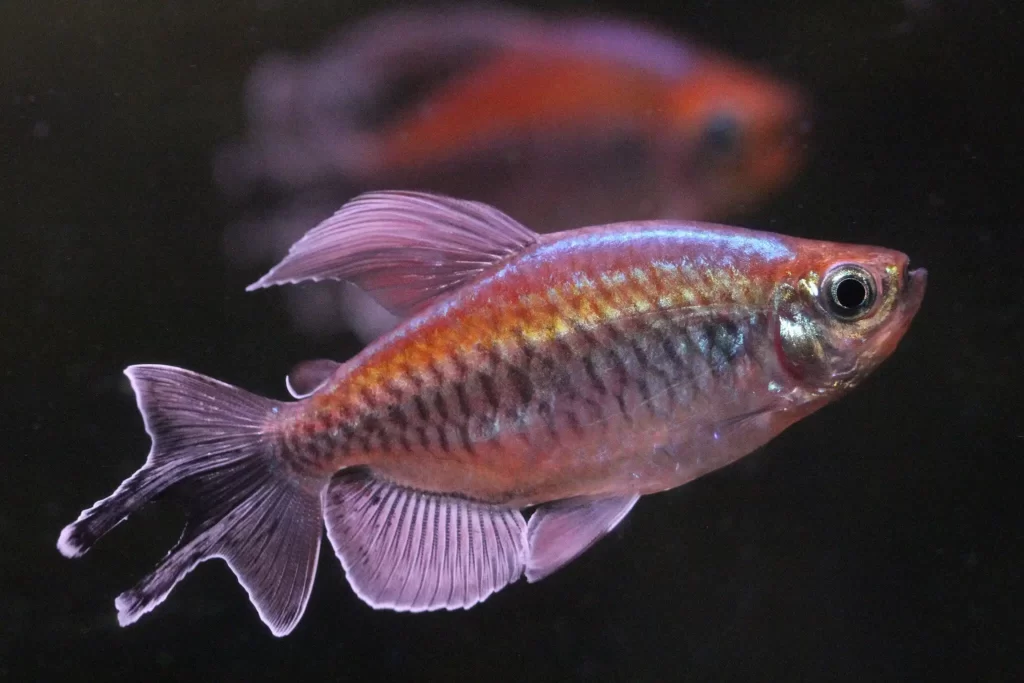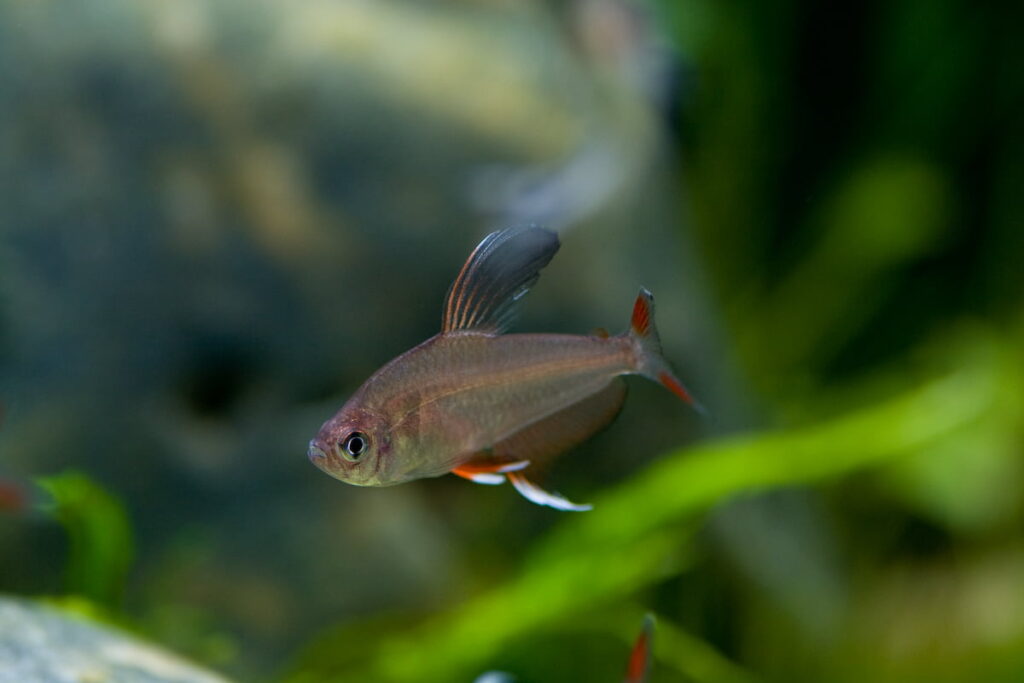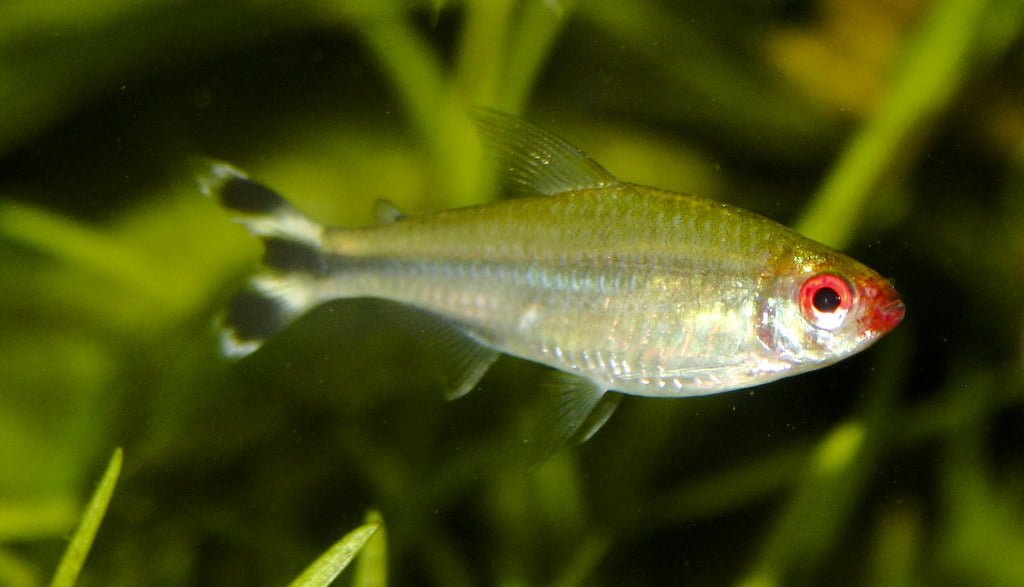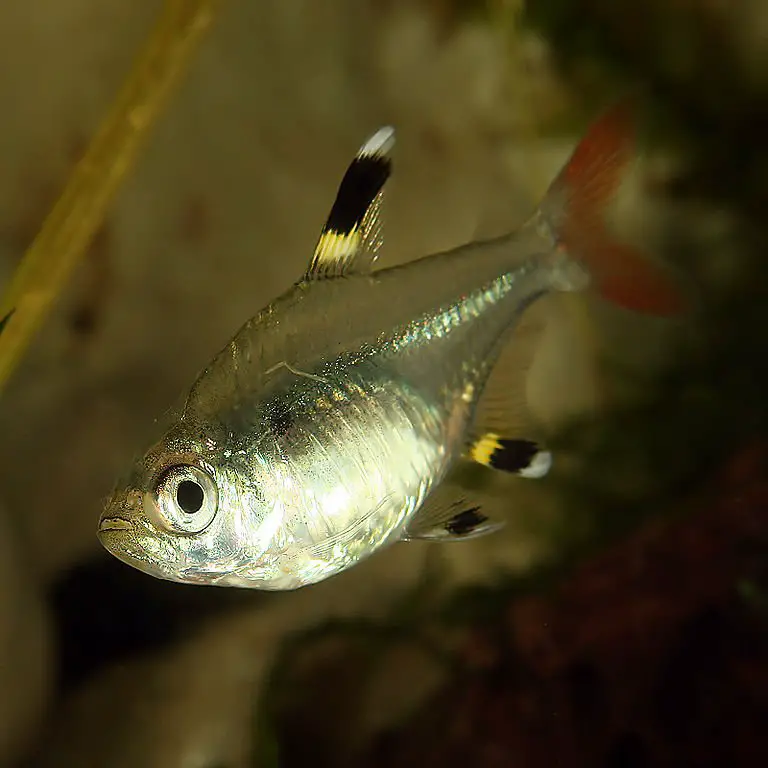The tetra fish family consists of over 700 known species. Among these 700 tetras, Red-eye tetra (Scientific Name: Moenkhausia sanctaefilomenae) is one of the elegant and widely available fish. Even though these tetras do not possess vibrant colors like other tetras, they are distinctive due to the unique red eye. This tetra’s body has a silver golden sheen with a yellow base in the tail fin.
Due to the tetras’ red-eye and the body color, they are also popular as Lamp Eye tetra, Yellow-banded Moenkhausia, and Yellowhead Tetra. These tetras are not particularly challenging to care for, as these tetras are very hardy and very easy to breed. You can find these tetras preferred even by the beginning aquarists. The red-eye tetras are very active fish and can live in good health when you keep them in a group of 5 or more maintaining their tank environment.
This article can provide you with insights that can help you understand more about the red-eye tetra. If you want to purchase a fish, you should understand the nature, origin, diet, tank conditions, and water quality of the aquarium.
Keep reading to know more.
Origin, Habitat in the Wild and Distribution
In 1907, Steindachne first described red eye tetras. These tetras are native to South America in Paraguay, regions of eastern Bolivia, eastern Peru as well as western Brazil.
The fish, in the wild, are mostly present in the clean flowing waters of big rivers. However, these tetras can sometimes swim and live in areas with thick vegetation, such as the dense vegetation of gloomy Amazon.
It mainly lives in clear rivers feeding the popular Pantanal wetlands, where dense aquatic vegetation is growing. The most common vegetation found is; the submerged plant called Eichhornia and Salvinia.
The red-eye does not fall in IUCN Red List, and you can find them broadly distributed in the wild. But, it is very unlikely for you to find any of the wild-caught fish in the pet stores. Due to its extreme popularity and demand, these tetras are captive-bred in the regions of Asia and Eastern Europe.
About Red-Eye Tetra
Let us get an in-depth knowledge regarding the appearance, availability, lifespan, and the price of the red-eye tetra to keep them successfully in your aquarium.
Among various tetras, these tetras fall under the category of large tetras, growing up to 2.5 inches. The fish is undemanding and easy to care for as long as you can maintain the water temperature and quality. These tetras can prosper in your tank if you have a large tank with enough space for them to swim freely.
Now, let us learn about them in detail.
Appearance
The red-eye tetras’ name comes from their distinctive marking on the upper part of its eye. The fish has a unique color pattern in their bodies with black and silver colorings. The body of these tetra fish can have a silvery golden sheen, which brings out their attractiveness.
The fish can be quite larger than other tetras and can grow up to 7 cm in length. One of the distinct features of this tetra is the yellow band on the base of their caudal fins. Because of this feature, the fish is also popular as Yellow-banded Moenkhausia.
Availability
The red-eye tetra usually inhabits in the clear water rivers. The fish feed on the famous Pantanal wetlands. These tetras mostly reside around the murky Amazon having thick vegetation.
The red-eye tetra you see in the market are mostly captive-bred. The breeding of these species nowadays takes place in the regions of Asia and Europe. The species are not that expensive, and these are widely available in the pet stores.
Life Span
With proper care of the aquarium environment, the red-eye tetras can live up to 3 to 5 years. In the wild, these tetras may be able to live for more than 5 years.
Price
These fish are active schooling fish, and you need to keep them in groups of 5. These are inexpensive fish with the price ranging from $1.29 per fish.
Sexual Difference
To determine the sexes of these tetras are generally difficult. Hence, the only way you could differentiate the male from female is their size. The female red eye tetras have a more round abdomen, as they have to store the eggs. The males have bright colors and look more shining as compared to females.
Social Behavior and Tank Mates
Most of the tetras are very social and good community fish. These tetras can live an enjoyable and stress-free life if you can keep them in a group of at least 6 red eyes. Since these are active fish, you need to put them with other active fish; otherwise, these tetras can intimidate and be energetic around other fish.
When these tetras are not in a group, they can show the behavior of fin nipping. You cannot keep the red-eye tetras with long-finned fish. Even when these fish are in their groups, they can usually squabble with other males.
Some of the good tank mates for the red-eye tetra are other species of tetras, rainbowfish, barbs, larger rasboras, and danios. These tetras also get along well with peaceful bottom dwellers as well.
Fishkeeping Difficulties
The red-eye tetra has excellent tolerance to a wide range of water parameters, which can help beginner fish keepers to set up an aquarium to their natural environment. These tetras, unlike other tetras, do not need soft water conditions.
These fish are very hardy and can adapt to different water conditions. However, you should not let the tank environment change drastically. If this happens, you can cause the fish to stress out, and that can affect the health of your fish.
Caring for Red Eye Tetra
Even though the fish is very hardy and is easy to care for, you need to maintain the environment of the tank. The aquarium tank is a closed ecosystem, and regardless of the fish’s adaptability, you need to make sure you take care of them.
There can be many changes in the water, such as decomposing organic matter, nitrates, and phosphates as well. The hardness of the water may increase due to evaporation. Therefore, you need to change 25 to 50% of the water every two weeks.
You should set up a tetra fish tank properly. Not only that, you will need to keep in mind about the fish’s diet, their behavior, and overall tank requirements. To know more about this in detail, continue reading further.
Tank Size
These fish are active swimmers and need space to swim in the tank. Hence, the tank size should be no less than 15 to 20 gallons. The bigger the tank size, the better for the fish as it gets to swim freely without any constraining. The fish can swim in all the areas in the aquarium, especially in front of the aquarium.
Also, keep in mind that you only need to add 2 gallons of water for one inch of the fish. For instance, if you are planning to keep red-eye tetra, you need at least 6 fish. So, to calculate the tank size for 6 red-eye tetras here is the math: you need (size of fish * number of fish* 2)–> (2*6*2) 24 gallons of space.
Lightings
The lighting of the tank can play a vital role in bringing up the best coloration in red-eye. Like most of the tetra fish, these tetras also prefer to be kept in the dim lighting. As the fish comes from a river that has heavy and dense plants, you need to make sure that there is only little lighting.
It is necessary to plant your tank as per the fish’s natural habitat. The plants also can help in bringing out the tint in water. So, plant your aquarium densely so that the fish has enough hiding place.
Decorations and Substrate
The ideal aquarium for the red-eye tetra can contain decorative items such as live plants, driftwoods, and rocks so that it represents their natural habitat. The fish needs a lot of hiding space, so make sure you have enough vegetation.
These tetras are comfortable in woodworks as well as floating plants. It can be great for the fish if you can add dry leaves into the tank. These plants can help in balancing the tank environment as plants play a vital role in photosynthesis. These plants can use nitrates as fertilizer that aids in photosynthesis.
For the substrate, you can use river sand or aquarium soil if you are planning to go for a planted tank.
Fish Diet
The red-eye tetra, like most fish, is omnivores. It means that you can feed these tetras with a wide variety of foods. Hence, this makes it very easy to feed them.
We already have an article about the tetra fish diet. Please go through the article to find out more about their diet.
In the wild, these tetras often feed on worms, crustaceans, and insects. In the aquarium, you can feed them the same. If it becomes difficult to find these items, you can feed them fine flake food, small granules, live or frozen brine shrimp, daphnia, tubifex, and bloodworms.
You can also feed the fish vegetables regularly, as this helps to bring out their color and appearance. The red-eye prefers to eat multiple times a day. So, you need to feed the tetras in small quantities and only the food that they can consume within 3 minutes.
Maintain Water Quality
The changes in the water conditions are very important in the aquarium. You can use filters and other equipment for maintenance, but it is not always enough. Some can argue that rivers and lakes do not have any filters in the system, so why is it necessary to maintain the water in the aquarium? It is needed as the rivers and streams are constantly flowing and never idle. Nevertheless, the aquarium tank stays the same if you do not change the water.
An aquarium is a small and closed system, and whatever you add into it can disrupt the environment. Installing the filters can help to improve the water quality, but you need to maintain the filters as well. The filters can get clogged and can cause more harm. You also need to remove and clean all the uneaten foods and the waste produced. Without this, there can be septic diseases for the fish.
You can know more factors such as water temperature, pH level, hardness, filtration, etc. in details further in this article.
Temperature
You need to maintain and monitor the temperature of the tank closely. The temperature should be in the range of 72.0° to 82° F only. If the temperature exceeds more than that, it can decrease the lifespan of the fish by increasing the metabolism.
pH and hardness
Maintaining the pH level is important to balance the acidity of the water. The pH level should be within the range of 5.5 to 8.5.
The hardness can help dissolve minerals in the water. The hardness for the red-eye should be within 2 to 30 dGH.
Filtration
Occasionally, the water inside the tank will change dramatically due to the presence of various contaminants and the excretion of fish. We, therefore, need to flush out potential toxins from the tank. Using a filter can help you keep the tank clean.
In the case of red-eye tetra, you may need to add aquarium-safe peat to the filter to simulate the black water conditions. These fish do not like fast-moving currents, so you need to adjust the filters in an angle to avoid any disturbance in the tank.
Filtration can help in improving the nitrogen cycle of the tank. It helps remove toxins, nitrate, and bio waste and improve the cycle. It helps to maintain the oxygen level of the tanks as well.
Read Full Article of Aquarium Filter for Tetra fish.
Fish Diseases
If you keep any kind of fish in a confined space, they are prone to many diseases. There is less risk of fish suffering from any disease if you maintain the tank structure and the ecosystem properly. The diet of the red-eye tetra also plays a role in fish diseases.
However, the fish are susceptible to diseases such as skin flukes, parasitic infestations (protozoa, worms, etc.), ichthyobodo infection, parasitic infestations (protozoa, worms, etc.), bacterial infections (general), and bacterial disease.
Breeding Red Eye Tetra
It is not that difficult to breed the red-eye tetra. For breeding tetras, you need to set up a separate breeding tank to help the fish fry. The size of the tank can be 20 gallons. The temperature of the tank can be up to 80° to 84° F (26.6 to 29° C). The pH level of the tank should be 5.5 to 6.5, with the hardness of 4 dGH or less. You can also add a layer of mesh small enough to keep parents out.
The female red-eye lays over several hundred eggs. The male fertilizes the eggs after females lay them. These tetras are the ones that must not have too dense vegetation for spawning. You need to keep the tank with spawning mops or java moss to provide the fish a place to deposit the eggs. The fry should have a gentle water flow, so you need to install a small, air-powered sponge filter. Aquarium-safe peat can also help filter out the water.
You can spawn the red-eye tetras in pairs, but you need to pair them with groups of 12 for the best results. You need to condition the male and female tetras separately before the breeding. Then you select a breeding pair or groups and transfer them into the breeding tank. The preferred time for spawning is in the morning.
After the spawning is over, you should remove the parents because they can eat the eggs. The eggs will hatch after 24 to 36 hours. You can feed the fish fry infusoria-type foods. After the fry grows, you can feed them with micro-worm or brine shrimp nauplii.
Conclusion
I hope that you can get to learn more about red-eye tetra through this article. I hope that you have the gist of what to do and not to do if you want to purchase this fish. These tetras are very stunning in the aquarium, and if you take care of them, they will shine and brighten your aquarium.
Reference
Image Credit: Cedricguppy – Loury Cédric [CC BY-SA (https://creativecommons.org/licenses/by-sa/4.0)]




